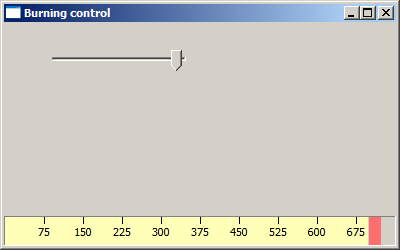Custom controls in Windows API
last modified October 18, 2023
Here we demonstrate, how to create our own custom controls. Windows API has a collection of various prebuilt controls. More specific controls have to be created manually. We use the GDI to create custom controls.
The Burning control
This control can be found in various media burning applications, like Nero Burning ROM.
#include <windows.h>
#include <commctrl.h>
#include <wchar.h>
LRESULT CALLBACK PanelProc(HWND, UINT, WPARAM, LPARAM);
LRESULT CALLBACK WndProc(HWND, UINT, WPARAM, LPARAM);
HINSTANCE g_hinst;
LRESULT g_pos = 150;
int WINAPI wWinMain(HINSTANCE hInstance, HINSTANCE hPrevInstance,
PWSTR lpCmdLine, int nCmdShow)
{
HWND hwnd;
MSG msg;
WNDCLASSW wc = {0};
wc.lpszClassName = L"Application";
wc.hInstance = hInstance;
wc.hbrBackground = GetSysColorBrush(COLOR_3DFACE);
wc.lpfnWndProc = WndProc;
wc.hCursor = LoadCursor(0, IDC_ARROW);
g_hinst = hInstance;
RegisterClassW(&wc);
hwnd = CreateWindowW(wc.lpszClassName, L"Burning control",
WS_OVERLAPPEDWINDOW | WS_VISIBLE | WS_CLIPCHILDREN,
100, 100, 400, 250, 0, 0, hInstance, 0);
while( GetMessage(&msg, NULL, 0, 0)) {
DispatchMessage(&msg);
}
return (int) msg.wParam;
}
LRESULT CALLBACK WndProc(HWND hwnd, UINT msg,
WPARAM wParam, LPARAM lParam)
{
static HWND hwndTrack, hwndBurn;
WNDCLASSW rwc = {0};
INITCOMMONCONTROLSEX InitCtrlEx;
InitCtrlEx.dwSize = sizeof(INITCOMMONCONTROLSEX);
InitCtrlEx.dwICC = ICC_BAR_CLASSES;
InitCommonControlsEx(&InitCtrlEx);
switch(msg)
{
case WM_CREATE:
rwc.lpszClassName = L"BurningControl";
rwc.hbrBackground = GetSysColorBrush(COLOR_BTNFACE);
rwc.style = CS_HREDRAW;
rwc.lpfnWndProc = PanelProc;
rwc.hCursor = LoadCursor(0, IDC_ARROW);
RegisterClassW(&rwc);
hwndBurn = CreateWindowExW(WS_EX_STATICEDGE , L"BurningControl", NULL,
WS_CHILD | WS_VISIBLE, 0, 330, 490, 30, hwnd, (HMENU)1, NULL, NULL);
hwndTrack = CreateWindowExW(0, TRACKBAR_CLASSW, NULL,
WS_CHILD | WS_VISIBLE | TBS_FIXEDLENGTH | TBS_NOTICKS,
40, 25, 150, 25, hwnd, (HMENU) 2, g_hinst, NULL);
SendMessage(hwndTrack, TBM_SETRANGE, TRUE, MAKELONG(0, 750));
SendMessage(hwndTrack, TBM_SETPAGESIZE, 0, 20);
SendMessage(hwndTrack, TBM_SETTICFREQ, 20, 0);
SendMessage(hwndTrack, TBM_SETPOS, TRUE, 150);
break;
case WM_SIZE:
SetWindowPos(hwndBurn, NULL, 0, HIWORD(lParam)-30,
LOWORD(lParam), 30, SWP_NOZORDER);
break;
case WM_HSCROLL:
g_pos = SendMessage(hwndTrack, TBM_GETPOS, 0, 0);
InvalidateRect(hwndBurn, NULL, TRUE);
break;
case WM_DESTROY:
PostQuitMessage(0);
break;
}
return DefWindowProcW(hwnd, msg, wParam, lParam);
}
LRESULT CALLBACK PanelProc(HWND hwnd, UINT msg,
WPARAM wParam, LPARAM lParam)
{
HBRUSH hBrushYellow, hBrushRed, holdBrush;
HPEN hPen, holdPen;
HFONT hFont, holdFont;
PAINTSTRUCT ps;
RECT rect, rect2;
wchar_t *cap[] = { L"75", L"150", L"225", L"300", L"375", L"450",
L"525", L"600", L"675"};
HDC hdc;
int till;
int step, full;
int i;
switch(msg)
{
case WM_PAINT:
hdc = BeginPaint(hwnd, &ps);
GetClientRect(hwnd, &rect);
till = (rect.right / 750.0) * g_pos;
step = rect.right / 10.0;
full = (rect.right / 750.0) * 700;
hBrushYellow = CreateSolidBrush(RGB(255, 255, 184));
hBrushRed = CreateSolidBrush(RGB(255, 110, 110));
hPen = CreatePen(PS_NULL, 1, RGB(0, 0, 0));
holdPen = SelectObject(hdc, hPen);
hFont = CreateFontW(13, 0, 0, 0, FW_MEDIUM, 0, 0, 0, 0,
0, 0, 0, 0, L"Tahoma");
holdFont = SelectObject(hdc, hFont);
if(till > full) {
SelectObject(hdc, hBrushYellow);
Rectangle(hdc, 0, 0, full, 30);
holdBrush = SelectObject(hdc, hBrushRed);
Rectangle(hdc, full, 0, till, 30);
} else {
holdBrush = SelectObject(hdc, hBrushYellow);
Rectangle(hdc, 0, 0, till, 30);
}
SelectObject(hdc, holdPen);
for ( i = 1; i < 10; i++) {
MoveToEx(hdc, i*step, 0, NULL);
LineTo(hdc, i*step, 7);
rect2.bottom = 28;
rect2.top = 8;
rect2.left = i*step-10;
rect2.right = i*step+10;
SetBkMode(hdc, TRANSPARENT) ;
DrawTextW(hdc, cap[i-1], wcslen(cap[i-1]), &rect2, DT_CENTER);
}
SelectObject(hdc, holdBrush);
DeleteObject(hBrushYellow);
DeleteObject(hBrushRed);
DeleteObject(hPen);
SelectObject(hdc, holdFont);
DeleteObject(hFont);
EndPaint(hwnd, &ps);
break;
}
return DefWindowProcW(hwnd, msg, wParam, lParam);
}
In our example, we display a trackbar control and our custom burning control. The trackbar control is used to control the state of the burning control.
The burning control is a simple window. It is placed on the bottom of the
parent window. It is completely drawn during the WM_PAINT message.
The lines, text, and background is drawn using the GDI function calls.

In this part of the Windows API tutorial, we have created a Burning custom control.